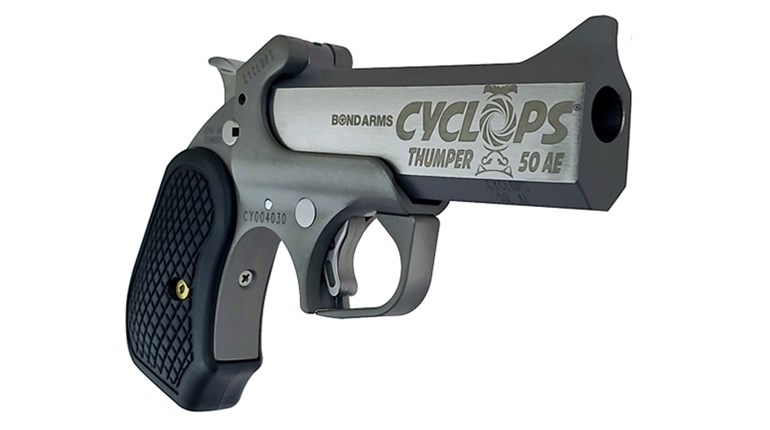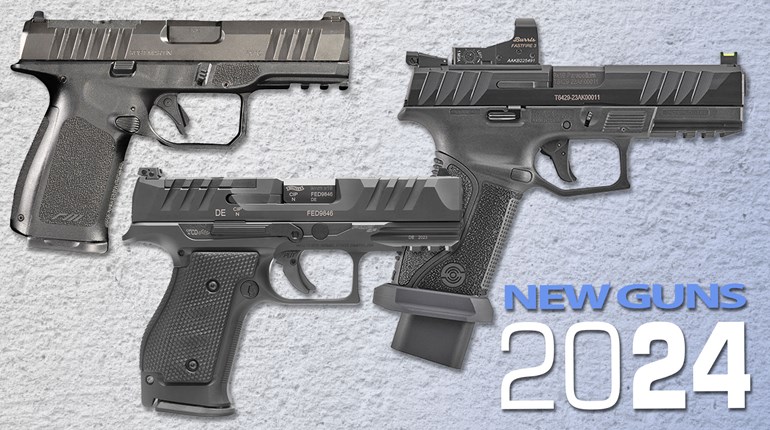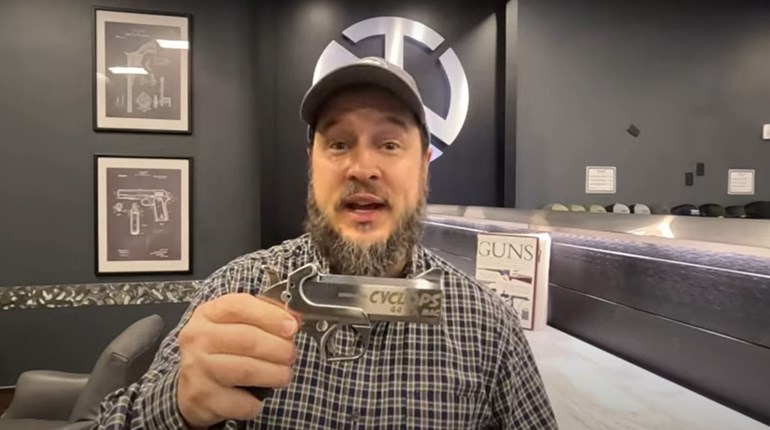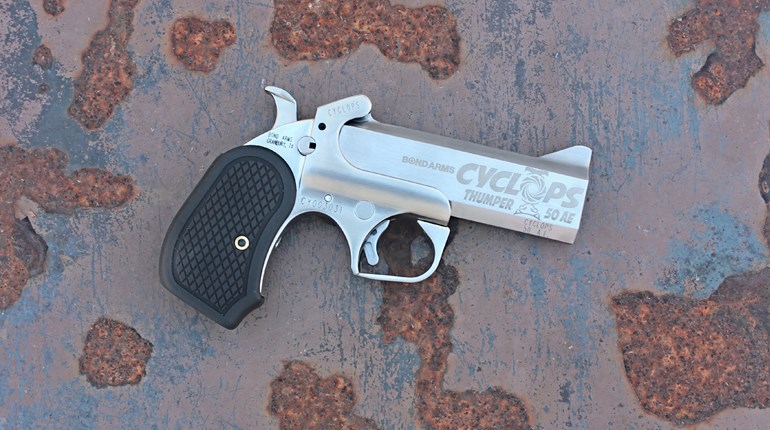Last year, Bond Arms of Granbury, Texas, unleashed its one-eyed derringer dubbed the Cyclops. The first model out the door was a Rough Series model chambered for the venerable .45-70 Government straight-walled rifle cartridge. But with all of the platform modifications in place to transform this company's big-bore double-barrel pistol into an even bigger-bore single-shot, there's plenty of room in the catalog for Cyclops pistols in additional calibers that are too big or stout for the over-under version. This evaluation (click here for the accompanying video) takes a closer look at the recently released Cyclops Thumper .44 Magnum models along with the new-for-2024 version chambered in the customer requested .50 Action Express.

The .44 Mag. and .50 AE Thumpers will be available as complete pistols only (no accessory barrels for now). The laser engraving has been simplified with the left side and muzzle markings found on the original .45-70 Gov't. version omitted to help reduce prices. Customers can pick from two finish options. The Rough Series models, which leave the frame and parts of the barrel unpolished, will have a suggested retail of $649. The other option is called the Satin Package. These pistols are fully polished and ship with a snap-strap leather belt holster featuring the Cyclops logo for $847.

The two new 4.25-inch Thumper models are mechanically identical to the original Cyclops with all-stainless steel construction. The barrel's hinge pin is removable which implies caliber conversion accessory barrels will be available for the single-shot models at some point in the future. The front sight blade and rear sight notch are fixed. A thumbnail notch cut in the left side of the chamber serves as a witness hole and aides in extracting spent cartridge cases. These models ship with a removable trigger guard and a B6 resin extended grip which supports the little finger of the shooting hand. The .45-70 Gov't. version tips the scales at 28 ounces. The .44 Mag. version goes up a bit to 28.2 ounces, but the metal removed for the larger bore of the .50 AE shaves it down to an unloaded weight of 27 ounces.

I received the .44 Mag. Satin Package with one of the very first writer sample, production-grade .50-caliber barrels. It was probably still warm from the laser engraver when it went into the box. Instead of swapping barrels around at the shooting range, I went ahead and mounted the .50 AE barrel to the Rough Series .45-70 Gov't frame I still had on hand. The single-action trigger pulls were 6 pounds 9 ounces and 6 pounds 7 ounces respectively.

The most interesting aspect of the Bond big-bore pistol design is their unexpected bullet velocity to gun size ratio. Due to their 19th century pocket-pistol heritage, these are by no means handgun hunting or long range competition pistols. I've found that when I'm pulling the trigger I can keep the 5-shot group sizes to a useful defensive accuracy of around 3 to 3.5 inches at a target distance of 7-yards.
However, the hinged-barrel design fires cartridges from a closed breech, much like a bolt-action rifle. The absence of a semi-automatic's shifting bolt assembly, or a revolver's cylinder gap, keeps all of the pressure generated by the burning powder directly behind the bullet until it leaves the barrel.

How much speed a bullet can develop from these 4.25 inch barrels depends a good deal on the cartridge. With the .45-70 Gov't. version of the Cyclops, the nominal cartridge case length of 2.105 inches leaves just 2.145 inches of rifled bore for the powder charge to burn before launching the .458-caliber rifle-cartridge bullets.

But the performance dynamics change in two ways when a Cyclops is chambered in .44 Mag. or .50 AE. First, both of these rounds have nominal case lengths of 1.285 inches for a working bore length of 2.965 inches. That means the barrel is just 0.035 inches shy of 3-inches long, which is a fairly common short-barrel length for .44 Mag. revolvers. For example, the Smith & Wesson Model 69 ships with a 2.75-inch barrel. Secondly, these two cartridges sport powder charges tuned specifically for handgun-length barrels. Yes, it's still a relatively short stretch of rifling, but the faster-burning powder can get more work done before the bullet leaves the muzzle.

I saw this bullet-velocity to gun-size ratio in action a few years ago when firing the Bond Arms Defender 10 mm Auto model using 3 inch and 4.25 barrels. As with the 10 mm Auto, the .44 Mag. and .50 AE demonstrated a notable drop in velocity when compared to the ammunition maker's listed velocities. However, it was not as much as you might expect.
The test gear arrived just days ahead of the 2024 SHOT Show in Las Vegas. As a result, I had to scramble to line up ammunition in time for this review, including some 50 AE loads which are hard to find right now. That's why I would like to give a special thanks to the good folks at Double Tap and Hornady for supporting this review with ammunition sent post haste to meet the deadline. Here are the results of the formal range test using a Lab Radar chronograph to measure bullet speeds and accuracy measured for three bench rested 5-shot groups fired at 7-yards:

The Thumper .44 Mag. and the converted .50 AE Cyclops both proved to be utterly reliable at the range. They fed and fired all rounds tested without any mechanical issues related to the pistols or the B6 resin grips. The B6 panels are ideal field grips specifically designed and formulated to stand up to the intense levels of recoil some loads produce.

The B6 grips showed no signs of fatigue, but I did. This is why I conducted some of the testing using the company’s laminated rosewood Jumbo grip. These grips are more hand filling and allow the pistols to roll back in the hand to aid in taking the edge off of the recoil when pounding away at a bench rest. However, I ran into the same problem with the .50 AE as with the hotter .45-70 Gov't loads. The laminated wood cracked and chipped at the top of the back strap, just under the hammer. Nevertheless, they remained usable until the testing was concluded. I would like to see Bond Arms develop a synthetic Jumbo Grip, or, better yet, a Bisley grip for these models.

That brings us to the burning question of the day: how's the recoil? Felt recoil is subjective so the best I can do as a writer is share what it was like for me and let folks judge for themselves if this is a shooting experience they want to pursue. That being said, I've shot a fair share of big-bore handguns over the years along with other fairly energetic Bond Arms models. Based on that experience, here is my unofficial felt-recoil scale. It starts at Mild, which would include guns like .22 LR pistols and rifles. From there the levels are Moderate, Stout, Intense with the last slot reserved for Painful. I've found that Stout and Intense can be fun, but Painful just isn't for me.

The .44 Special loads were Moderate at most with shoot-all-day levels of manageable recoil. The .44 Mag. hunting load took the recoil right up to the Intense range. But with .44 Mag there are a variety of loads and energy levels to choose from along with the softer shooting .44 Special.

As for the .50 AE, recoil stayed in the Intense range from start to finish. There's nothing subtle about touching off these little brass hand grenades in a four and a half pound Desert Eagle pistol. So shooting them from the 27 ounce Thumper was much like testing the Charter Arms Mag Pug chambered in .41 Rem. Mag. Early on it was pretty exciting. But after a while, with only souped-up hunting loads to shoot, it felt like there was nowhere to hide behind this hand cannon. Let's just say I took a few breaks along the way before the range session was concluded.

I highly doubt that most folks are ever going to hunker down at a bench rest to cap off $3 per shot .50 AE ammunition box after box the way I did for the formal testing. But hopefully it's clear by now that the Cyclops Thumpers loaded with full power .44 Mag or .50 AE are not for the faint-hearted or for first-time shooters.
The Cyclops series lives up to Bond Arms' motto of making some of the smallest, most powerful pistols you can buy. Now that there's a .50-caliber option, what's next? The company is currently focused on launching the lever-action, AR-15 cartridge-compatible LVRB rifle. It will be available chambered in popular calibers including 5.56 NATO/.223 Rem., .300 Blackout, .350 Legend and .450 Bushmaster. Once the LVRB rifle ships then the caliber-compatible Cyclops pistols, chambered in the same AR rounds, won’t be too far behind.

Specifications:
- Manufacturer: Bond Arms, Granbury Texas, USA; bondarms.com
- Model: Cyclops Thumper Satin Package with Holster
- Action: Break-Action, Single-Shot Derringer
- Caliber: .44 Magnum/.44 Special
- Barrel: 4.25" Satin Finish Stainless Steel
- Grip Frame: Satin Finish Stainless Steel
- Grip: Black Textured B6 Resin
- Sights: Integral Blade Sight Front, Fixed Notch Rear
- Overall Length: 6.75 inches
- Height: 4.37 inches
- Width: 0.97 inches (frame); 1.28 inches (grip)
- Trigger Pull: 6 pounds 9 ounces (As Tested)
- Weight: 28.2 ounces
- Capacity: 1 round
- Accessories: Leather Belt Holster, Foam Lined Case, Owner's Manual
- Suggested Retail: Rough Series Pistol (No Holster) $649; Satin Finish Pistol & Holster $847

























